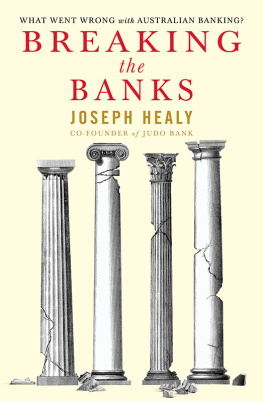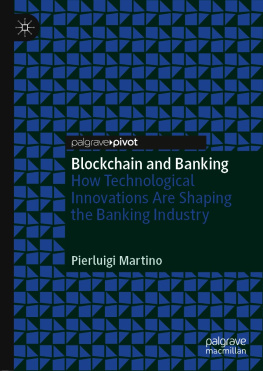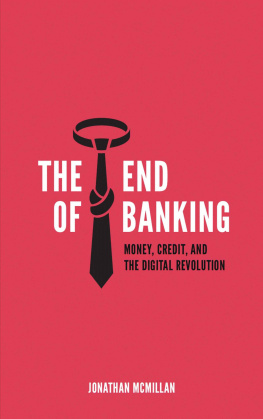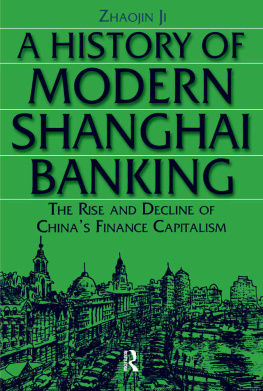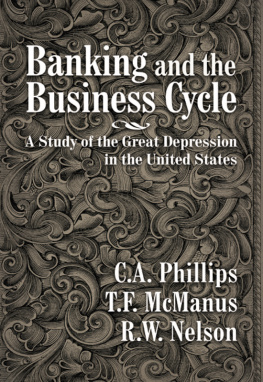Microeconomics of Banking
Microeconomics of Banking
Second Edition
Xavier Freixas and Jean-Charles Rochet
The MIT Press
Cambridge, Massachusetts
London, England
2008 Massachusetts Institute of Technology
All rights reserved. No part of this book may be reproduced in any form by any electronic or mechanical means (including photocopying, recording, or information storage and retrieval) without permission in writing from the publisher.
MIT Press books may be purchased at special quantity discounts for business or sales promotional use. For information, please email or write to Special Sales Department, The MIT Press, 55 Hayward Street, Cambridge, MA 02142.
This book was set in Times New Roman on 3B2 by Asco Typesetters, Hong Kong.
Printed and bound in the United States of America.
Library of Congress Cataloging-in-Publication Data
Freixas, Xavier.
Microeconomics of banking / Xavier Freixas and Jean-Charles Rochet.2nd ed.
p. cm.
Includes bibliographical references and index.
ISBN 978-0-262-06270-1 (hardcover : alk. paper)
ISBN 978-0-262-30385-9 (e-book)
1. Banks and banking. 2. FinanceMathematical models. 3. Microeconomics. I. Rochet, Jean-Charles. II. Title.
HG1601.F74 2008
302.13dc22 2009037119
10 9 8 7 6 5 4 3 2 1
d_r0
A la mmoire de Jean-Jacques Laffont
Figures
Preface
During the last three decades, the economic theory of banking has entered a process of change that has overturned economists traditional view of the banking sector. Before that, the banking courses of most doctoral programs in economics, business, or finance focused either on management aspects (with a special emphasis on risk) or on monetary aspects and their macroeconomic consequences. Thirty years ago, there was no such thing as a microeconomic theory of banking, for the simple reason that the Arrow-Debreu general equilibrium model (the standard reference for microeconomics at that time) was unable to explain the role of banks in the economy.
Since then, a new paradigm has emerged (the asymmetric information paradigm), incorporating the assumption that different economic agents possess different pieces of information on relevant economic variables and will use this information for their own profit. This paradigm has proved extremely powerful in many areas of economic analysis. In banking theory it has been useful in explaining the role of banks in the economy and pointing out the structural weaknesses of the banking sector (exposure to runs and panics, persistence of rationing on the credit market, recurrent solvency problems) that may justify public intervention.
This book provides a guide to this new microeconomic theory of banking. It focuses on the main issues and provides the necessary tools to understand how they have been modeled. We have selected contributions that we found to be both important and accessible to second-year doctoral students in economics, business, or finance.
What Is New in the Second Edition?
Since the publication of the first edition of this book, the development of academic research on the microeconomics of banking has been spectacular. This second edition attempts to cover most of the publications that are representative of these new developments. Three topics are worth mentioning.
First, the analysis of competition between banks has been refined by paying more attention to nonprice competition, namely, competition through other strategic variables than interest rates or service fees. For example, banks compete on the level of the asset risk they take or the intensity of the monitoring of borrowers. These dimensions are crucial for shedding light on two important issues: the competition-stability trade-off and the effect of entry of new banks, both of concern for prudential regulation.
Second, the literature on the macroeconomic impact of the financial structure of firms has made significant progress on at least two questions: the transmission of monetary policy and the effect of capital requirements for banks on the functioning of the credit market.
Finally, the theoretical foundations of banking regulation have been clarified, even though the recent developments in risk modeling (due in particular to the new Basel accords on banks solvency regulation) have not yet led to a significant parallel development of economic modeling.
Prerequisites
This book focuses on the theoretical aspects of banking. Preliminary knowledge of the institutional aspects of banking, taught in undergraduate courses on money and banking, is therefore useful. Good references are the textbooks of Mishkin (1992) or Garber and Weisbrod (1992). An excellent transition between these textbooks and the theoretical material developed here can be found in Greenbaum and Thakor (1995).
Good knowledge of microeconomic theory at the level of a first-year graduate course is also needed: decision theory, general equilibrium theory and its extensions to uncertainty (complete contingent markets) and dynamic contexts, game theory, incentives theory. An excellent reference that covers substantially more material than is needed here is Mas Colell, Whinston, and Green (1995). More specialized knowledge on contract theory (Salani 1996; Laffont and Martimort 2002; Bolton and Dewatripont 2005) or game theory (Fudenberg and Tirole 1991; Gibbons 1992; Kreps 1990; Myerson 1991) is not needed but can be useful. Similarly, good knowledge of the basic concepts of modern finance (Capital Asset Pricing Model, option pricing) is recommended (see, e.g., Huang and Litzenberger 1988 or Ingersoll 1987). An excellent complement to this book is the corporate finance treatise of Tirole (2006). Finally, the mathematical tools needed are to be found in undergraduate courses in differential calculus and probability theory. Some knowledge of diffusion processes (in connection with Black-Scholess option pricing formula) is also useful.
Outline of the Book
Because of the discouraging fact that banks are useless in the Arrow-Debreu world (see we explore the different theories of financial intermediation: transaction costs, liquidity insurance, coalitions of borrowers, and delegated monitoring.
The second important aspect that is neglected in the complete contingent market approach is the notion that banks provide costly services to the public (essentially management of loans and deposits), which makes them compete in a context of product differentiation. This is the basis of the industrial organization approach to banking, studied in .
we study the equilibrium of the credit market, with particular attention to the possibility of rationing at equilibrium, a phenomenon that has provoked important discussions among economists.
is concerned with bank regulation and its economic justifications.
Teaching the Book
According to our experience, the most convenient way to teach the material contained in this book is to split it into two nine-week courses. The first covers the most accessible material of . At the end of most chapters we have provided a set of problems, together with their solutions. These problems not only will allow students to test their understanding of the material contained in each chapter but also will introduce them to some advanced material published in academic journals.
Acknowledgments
Our main debt is the intellectual influence of the principal contributors to the microeconomic theory of banking, especially Benjamin Bernanke, Patrick Bolton, Doug Diamond, Douglas Gale, Martin Hellwig, David Pyle, Joe Stiglitz, Jean Tirole, Robert Townsend, and several of their co-authors. We were also influenced by the ideas of Franklin Allen, Ernst Baltensperger, Sudipto Bhattacharya, Arnoud Boot, John Boyd, Pierre Andre Chiappori, Mathias Dewatripont, Phil Dybvig, Grard Gennotte, Charles Goodhart, Gary Gorton, Ed Green, Stuart Greenbaum, Andre Grimaud, Oliver Hart, Bengt Holmstrm, Jack Kareken, Nobu Kiyotaki, Hayne Leland, Carmen Matutes, Robert Merton, Loretta Mester, John Moore, Rafael Repullo, Tony Santomero, Elu Von Thadden, Anjan Thakor, Xavier Vives, Neil Wallace, David Webb, Oved Yosha, and Marie-Odile Yannelle. Some of them have been very helpful through their remarks and encouragement. We are also grateful to Franklin Allen, Arnoud Boot, Vittoria Cerasi, Gabriella Chiesa, Gerhard Clemenz, Hans Degryse, Antoine Faure-Grimaud, Denis Gromb, Loretta Mester, Bruno Parigi, Franois Salani, Elu Von Thadden, and Jean Tirole, who carefully read preliminary versions of this book and helped us with criticism and advice.
Next page

